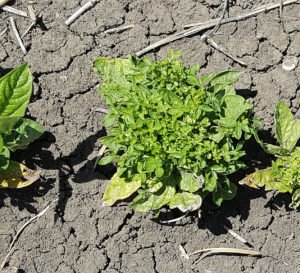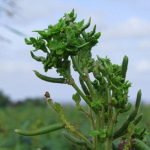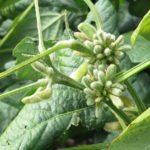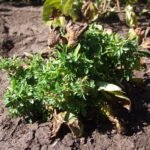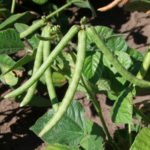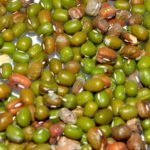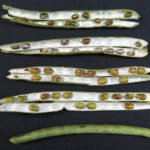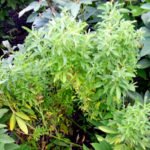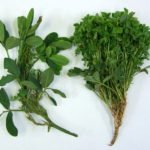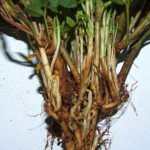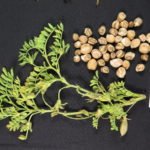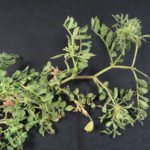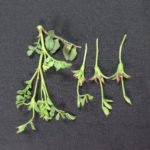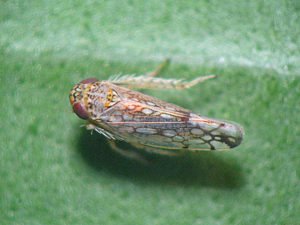
Common brown leaf hopper (3 mm). This is the most likely vector and has been widely observed in summer and winter pulses infected with phytoplasma. Note the distinctive dark reticulated patterns on the wings and body.
Last summer saw unprecedented levels of phytoplasma in summer pulses/legumes (including chickpeas, mungbeans and pigeon peas) in all cropping regions in eastern and northern Australia from the Ord Irrigation area (WA), Burdekin/Atherton Tablelands (NQ), to central NSW. The most likely insect vector is the brown leafhopper Orosius orientalis, which has been detected in recent (2017) spring crops. While plantings of spring mungbeans have been limited by dry weather in many regions, phytoplasma has been observed in spring 2017 Burdekin crops, but at lower levels than in the spring of 2016. Phytoplasma has also been observed in mostly low levels in many chickpea crops in Queensland and NSW.
Phytoplasmas are restricted to the plant host’s phloem tissue and are transmitted by phloem-feeding insect vectors. Orosius sp. leafhoppers have been documented as transmitting phytoplasma in Australia and overseas, and feed on the plant’s phloem tissue, In contrast, other bugs such as the green vegetable jassid (Austroasca viridigrisea) and Rutherglen bugs (Nysius vinitor) are not phloem feeders and are therefore most unlikely to have been responsible for the current outbreaks. Indeed, major previous outbreaks of vegetable jassids and Rutherglen bug have not coincided with phytoplasma outbreaks of the magnitude experienced in recent years.
- ‘Little pod symptoms’: Small, malformed and green pods that never reach harvest maturity.
- Little pod symptoms in soybeans
- Severely affected mungbean plant with no prospect of setting pods. About 33% of plants in this crop were similarly affected.
Last summer, early outbreaks in pre-flowering mungbeans were characterised by ‘little leaf’ symptoms, i.e. masses of undersized leaves in dense clumps. In flowering crops, symptoms exhibited include phyllody (where flowers develop abnormally into leafy structures) and little pod (where pods are deformed and remain small and green). Later infections appear to be associated with puffy pod symptoms in mungbeans. Because symptoms can take at least 2-3 weeks post-infection by leafhoppers to manifest themselves, growers/consultants are asked to regularly sample crops for leafhopper and other sucking bug activity.
- Puffy pod in mungbeans may be caused by late phytoplasma infections.
- Symptoms of this disorder include mottled pod walls and the production of brown seeds.
- Puffy pod symptoms in phytoplasma-infected mungbeans with netted pattern on pods and shrivelled, brown seeds.
At this stage, the easiest way to sample is with a sweep net. Take 20 sweeps in 20 paces at walking speed, and invert the catch into a large plastic or glass jar for easy observation. Take a number of such samples across the paddock as leafhopper numbers can vary greatly. Keep the samples to send away for identification if phytoplasma is detected later in the field.
Sampling with a beat sheet is not recommended, as the leafhoppers are small (3 mm) and often fly off before being counted. Liz Williams will be evaluating leafhopper monitoring methods this summer so watch this space.
Seed transmission is highly unlikely to be responsible for last season’s outbreaks, as the incidence of phytoplasma in pigeon pea crops in different paddocks (planted with the same seed) varied from very low to extremely high.
- Classic pigeon pea little leaf symptoms
- Phytoplasma in peanuts with masses of little leaves (normal-sized leaves shown on left)
- Phytoplasma in peanuts – upwardly-growing deformed pegs that did not produce any pods.
- Phytoplasma in kabuli chickpeas with proliferation of branching and small leaves, and phyllody. Note also the shrivelled, marked seeds from affected plants.
- Secondary leaves or flowering structures erupting from original flowers is common in infected chickpeas.
- Severely affected plants may not produce any pods.
Please report any outbreaks to entomologist Hugh Brier at DAF Kingaroy, and to plant pathologist Murray Sharman at DAF Brisbane (contact details below).
Leafhopper specimens should be sent to Hugh in small containers with sampling type (sweep net, etc.), date, crop (type and stage) and location details (including GPS coordinates). Note also the length of time between the sample and phytoplasma symptoms appearing (if applicable)
Infected plant samples should be sent to Murray Sharman for molecular (PCR) testing to determine the strain of phytoplasma in affected crops, distribution and host range. Send plant samples (just the affected parts) in a sealed plastic bag with paper towel inside to soak up condensation. Keep cool, but not frozen, and dispatch in an insulated container (a cardboard box with shredded paper insulation will do) via an express courier. Please email or call Murray to let him know the samples are coming, so that arrangements can be made to keep them cool on arrival.
Hugh Brier (0428 188 069; [email protected])
DAF
214 Kingaroy-Cooyar Road
Kingaroy QLD 4610
Murray Sharman
DAF, 2C-West
EcoSciences Precinct
Basement 3 loading dock (off Joe Baker St)
Dutton Park QLD 4102
Ph: 07 3255 4339
Mob: 0405 564 428 or 0467 721 400
[email protected]

